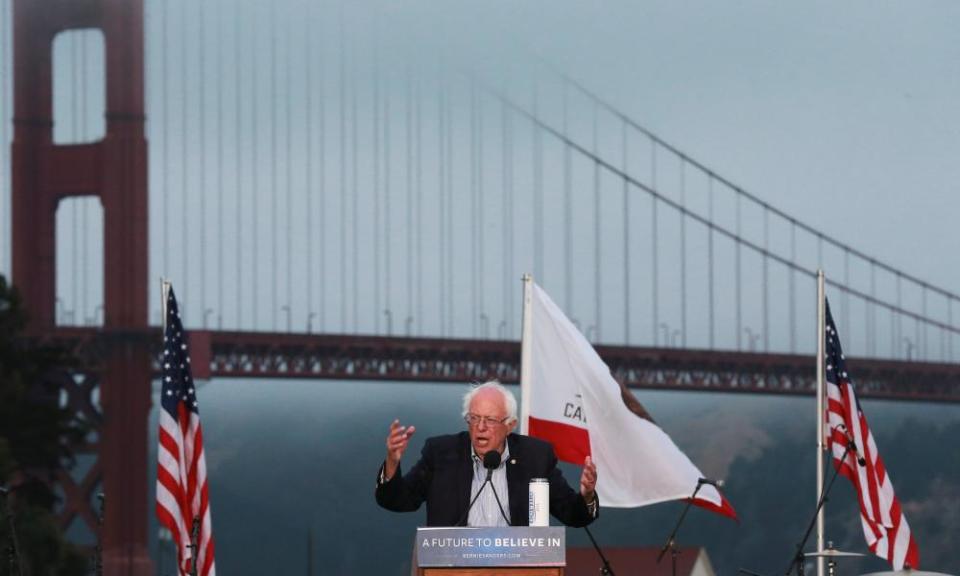California visit presents key test for Bernie Sanders' 2020 prospects

Bernie Sanders is bringing his anti-establishment message and calls for progressive reform to California, no longer as a long-shot presidential candidate seeking to change the terms of debate but as a frontrunner who knows he has a good chance to win it all.
Sanders’ visit to the Golden State this week – his first since announcing his new run for president – highlights California’s renewed importance in the presidential race. Its early primary, diverse electorate and progressive politics make it a key battleground for the independent senator from Vermont.
With rallies in San Diego, Los Angeles and San Francisco, Sanders is hoping to remind Californians of the message that resonated in 2016. Sanders lost California’s Democratic primary that year to Hillary Clinton, but his support for a universal, public healthcare system and fervent calls to end impunity for Wall Street made him popular with Democrats in the state.
Sign up for the US morning briefing
“When he first got in, he was a ‘message’ candidate,” said Michael Ceraso, a former aide who helped direct Sanders’ 2016 campaign in California. Sanders was also the “anti-candidate”, perceived by many as the ornery straight-shooter taking on Hillary Clinton’s careful, focus-group-tested centrism.
Related: If Sanders' attempt to win black voters is a redux of 2016, it won't be enough | Theodore R Johnson
Since then, much has changed. Signature Sanders proposals like Medicare for All are now embraced by many Democrats. Sanders himself has risen to national prominence – a member of the Senate Democrats’ leadership team with name recognition on par with former vice-president Joe Biden.
He faces a far more crowded, diverse and left-leaning Democratic primary field, where voters have a plethora of options when it comes to tone, and support for the progressive policies Sanders has long championed is increasingly the standard, not the exception. Sanders is also no longer the hot new thing, now viewed favorably by about as many voters as view him negatively, according to a 14-17 March survey by CNN.
And California’s role in the election is radically different. In 2016, California’s 7 June primary election was an afterthought, one that only sealed a by-then inevitable Clinton nomination. This time, the state’s primary is scheduled for 3 March. Early voting, through which the majority of voters in the state have cast their ballots in recent years, begins on 3 February, the same day as the Iowa caucus. Presidential hopefuls Amy Klobuchar, Tulsi Gabbard, Andrew Yang and Kirsten Gillibrand have all visited the state in recent weeks.
For Sanders, the California race will indicate whether he can overcome some of the challenges of his 2016 campaign, when his progressive record was sometimes obscured by controversy over comments on identity politics, reparations and immigration. White voters form a narrow plurality, not the majority in the state, and in the country’s largest, immigrant-dense county, Los Angeles, most residents speak a language other than English at home.
“It’s a diverse state, and its diversity is what makes it so interesting and important to the candidates,” Matt Barreto, a professor of Chicana/o Studies at UCLA who did polling for the Clinton campaign in 2016, told the Guardian. “None of those Democrats are going to win the 2020 presidential race without having strong support and very high turnout among communities of color. So California gives them an opportunity to try that out and see how effective they can be.”

Bernie Sanders speaks at a campaign rally in San Francisco on 6 June 2016.Photograph: Elijah Nouvelage/Reuters
Sanders toured California last fall, campaigning for Representative Barbara Lee. A progressive stalwart representing the East Bay, Lee didn’t really need the help, but the stop allowed Sanders to reintroduce himself to what Lee referred to as “the wokest district in the country”, and to demonstrate his good-soldier commitment to ending “one-party, reactionary rule in Washington” by electing more and better Democrats.
But Lee, who was one of the first to meet with Bernie about his 2016 run, is supporting someone else in 2020. Like California’s governor, Gavin Newsom, more than 30 state lawmakers and four other members of California’s congressional delegation, Lee is backing Senator Kamala Harris, California’s junior senator and former attorney general.
Related: Who is running for president? The full list of 2020 Democratic candidates
Sanders does have one elected Californian in his corner: Representative Ro Khanna, who represents Silicon Valley and serves as one of the Sanders campaign’s national co-chairs. Sanders also has the support of hundreds of delegates to the California Democratic party, Khanna told the Guardian, in another sign the Democratic party’s California chapter has shifted left in recent years.
“This means Senator Sanders will have a large grassroots army giving him a big advantage,” Khanna argued, adding he strongly believes Sanders’ “message of ending bad wars, tackling wealth and income inequality and pushing for bold policies to address climate change will resonate with California voters”.
However, Ceraso, the former Sanders aide, wonders if Bernie will ultimately be the one voters want to deliver that platform in 2020. “Are they looking for that same message in 2016, or are they looking for a different tone?”

